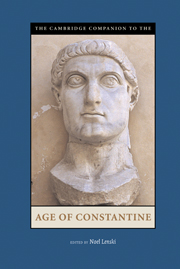Book contents
- Frontmatter
- Introduction
- 1 Sources for the History of Constantine
- Section 1 Politics and Personalities
- Section II Religion and Spiritual Life
- 5 The Impact of Constantine on Christianity
- 6 The Beginnings of Christianization
- 7 Traditional Religions
- Section III Law and Society
- Section IV Art and Culture
- Section V Empire and Beyond
- Appendix 1: Stemmata
- Appendix 2: Timeline
- Maps
- Primary Sources and Translations
- Secondary Bibliography
- Index
5 - The Impact of Constantine on Christianity
from Section II - Religion and Spiritual Life
Published online by Cambridge University Press: 28 September 2007
- Frontmatter
- Introduction
- 1 Sources for the History of Constantine
- Section 1 Politics and Personalities
- Section II Religion and Spiritual Life
- 5 The Impact of Constantine on Christianity
- 6 The Beginnings of Christianization
- 7 Traditional Religions
- Section III Law and Society
- Section IV Art and Culture
- Section V Empire and Beyond
- Appendix 1: Stemmata
- Appendix 2: Timeline
- Maps
- Primary Sources and Translations
- Secondary Bibliography
- Index
Summary
The impact of Constantine on Christianity can be summarized fairly quickly: during the thirty years of his reign, more change took place in the status, structure, and beliefs of the Christian Church than during any previous period of its history. In 306, when Constantine was first elevated by his father’s troops, the imperial government was in the middle of a concerted effort to remove all traces of Christian presence from the empire. When he died in 337, Christian leaders had assumed the rank, dress, and, increasingly, the duties of the old civic elite. Before the century ended, the tables were turned completely, with traditional sacrifices outlawed and the old state cults forbidden. But Constantine’s role in bringing about this reversal is more problematic. At one time, the only question that needed to be asked about that role was how “sincere” Constantine’s conversion had been. Was he in truth a pious son of the church, or was he rather a political mastermind who seized on the power he could gain by subordinating this well-organized and doctrinaire group to his will? Admirers pointed to the enormous powers and benefactions he bestowed upon the church, the Christian character of his laws, and his suppression of pagan cults. Those who argued the opposite pointed disdainfully at the continued presence of pagan images on his coins for some time after 312, his unwillingness to use any but the most general terms for deity in his public utterances, and, most damningly of all, evidence that he not only permitted the old cults to survive but even actively patronized them, at least on occasion.
- Type
- Chapter
- Information
- The Cambridge Companion to the Age of Constantine , pp. 111 - 136Publisher: Cambridge University PressPrint publication year: 2005
- 9
- Cited by

